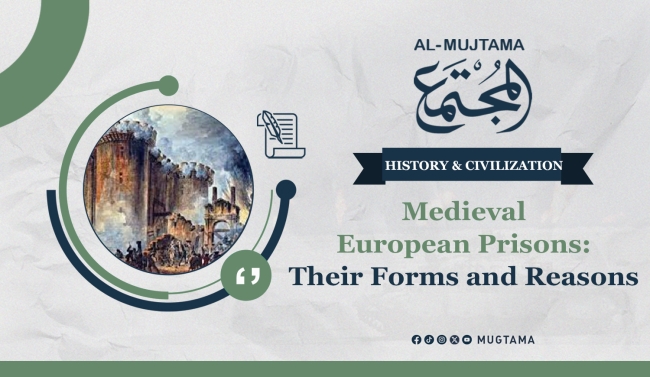Medieval European Prisons: Their Forms and Reasons
Those who have read "Les Misérables," one of the most detailed historical novels written by Victor Hugo, will understand its portrayal of 19th-century France. The novel explores deep social issues such as poverty, justice, mercy, and faith. The story revolves around Jean Valjean, a Frenchman imprisoned for stealing a loaf of bread to feed his starving family. Upon his release, he finds it difficult to reintegrate into society due to the stigma that follows him. He faces numerous hardships, oppression, and injustice.
Historical Context
The importance of this novel (and its artistic representation) lies in its realistic depiction of the pre-French Revolution era, highlighting social and economic life and the issue of missing justice. Despite the potential exaggeration in the literary text, the documented history of Europe in major historical references like "The Story of Civilization" by historian Will Durant confirms that the corruption in medieval European life was far greater than depicted in "Les Misérables." At that time, the majority in Europe had fewer rights than animals.
Nature of Prisons and Types of Punishment in the Middle Ages
Medieval prisons differed greatly from today's institutions. They were not designed for rehabilitation but served as temporary holding places before severe punishments were carried out or for detaining debtors, the insane, or slaves. These prisons were often stone towers or cellars within castles, fortresses, monasteries, and churches, and were not specifically designed for detention. Conditions were extremely harsh, dark, damp, crowded, and lacked hygiene. Prisoners faced diseases and epidemics, had minimal and unhealthy meals, and there was no separation of genders or types of crimes, leading to a mix of men, women, and children in the same place.
Corruption and Harsh Punishments
There were no fixed laws regulating the relationship between jailers and prisoners, and bribery played a significant role in the entire process. Bribery could be used to buy off the guards by prisoners or their families. Punishments during that time were extremely harsh for deterrence rather than reform. The punishment for stealing a loaf of bread could be several years of imprisonment, with a lifelong stigma and persecution, despite the harsh economic conditions forcing many to endure hunger for days.
Religious and Political Influence on Punishments
The Catholic Church played a major role in the severity of punishments, especially against those who disagreed with its scientific beliefs, like Galileo, who discovered that the sun, not the earth, is the center of the universe. The church believed the earth was the center of the universe. Despite historical doubts about Galileo being burned by the church, the church officially apologized in 1992 for its judgment against him. Life imprisonment was rare and usually led to execution.
Notable Severe Punishments
Among the harsh punishments for minor crimes was "enslavement," where a criminal could be sentenced to lifelong servitude. Exile to a distant place was a common punishment for some political crimes, and criminals were publicly shamed through flogging in public squares.
Reasons for Harsh Punishments
Life in the Middle Ages was inherently harsh, and prisons and punishment were just manifestations of that harshness. With the absence of a developed judicial system, convictions often relied on confessions obtained under torture or unreliable testimonies. The dominant church viewed class differences between people naturally, as if the rich and noble classes had the right to enslave others merely for being poor or propertyless.
Religious Perspective on Punishment
Punishment was seen as atonement for sins, with deterrence as the main goal to prevent others from committing crimes, believing that harsh punishment was the best way to achieve this in feudal societies. Harsh judgments were also believed to subdue political opponents and rebels and punish rebellious peasants who refused the orders of feudal lords, regardless of the simplicity or value of the stolen items. Religious punishments, which were more akin to vengeance than punishment, were among the harshest and were directed at those with beliefs contrary to Christian teachings.
Inquisition Courts: An Unforgivable Human Fall
The idea of establishing "Inquisition Courts" began in the 13th century when the Catholic Church was given free rein to control everything, and punishment was imposed based on people's intentions and thoughts. The Pope of Rome tasked bishops with acting as informers to investigate people's thoughts and whispers, accusing any dissident of heresy, and then punishing them with death or brutal torture.
Torture Techniques
In Andalusia, history recorded the most atrocious acts against humanity, where King Ferdinand of Aragon and Queen Isabella of Castile excelled in torturing those who did not convert to Christianity or secretly maintained their faith. Pope Sixtus IV issued a decree in November 1478, authorizing them to appoint six priests to form an Inquisition Court to investigate and punish heresy charges. The court targeted converted Jews and Muslims suspected of reverting to their old faiths and encouraged everyone to act as witnesses to inform on their neighbors, friends, and relatives.
Modern Reflections
The church's apology in 1992 for Galileo's judgment highlights the historical wrongs committed in the name of faith. The Inquisition, and the brutal torture methods it employed, represent a historical human fall that cannot be forgiven, especially against Muslims or those opposed to Catholic Christianity.
---------------------------------------------
Sources
- Will Durant: An American philosopher, historian, and writer, born on November 5, 1885, in North Adams, Massachusetts, USA. He is best known for his work "The Story of Civilization," co-authored with his wife, Ariel Durant.
- "The Story of Civilization" by Will Durant: Adapted from this major historical reference.
- Galileo Galilei: An Italian astronomer, philosopher, and physicist born in Pisa, Italy. Sometimes described as a polymath, he published and strongly defended the heliocentric theory proposed by Copernicus. Galileo first disproved Aristotle's theory of motion through observation and experimentation. (Wikipedia, born on February 15, 1564).
- The Historical Encyclopedia, adapted from the Umayyad era (Islamic History): Taken from the news of the people of Andalusia by Hayyan ibn Khalaf al-Qurtubi.
- Previous Source: Additional information from the same historical encyclopedia.


